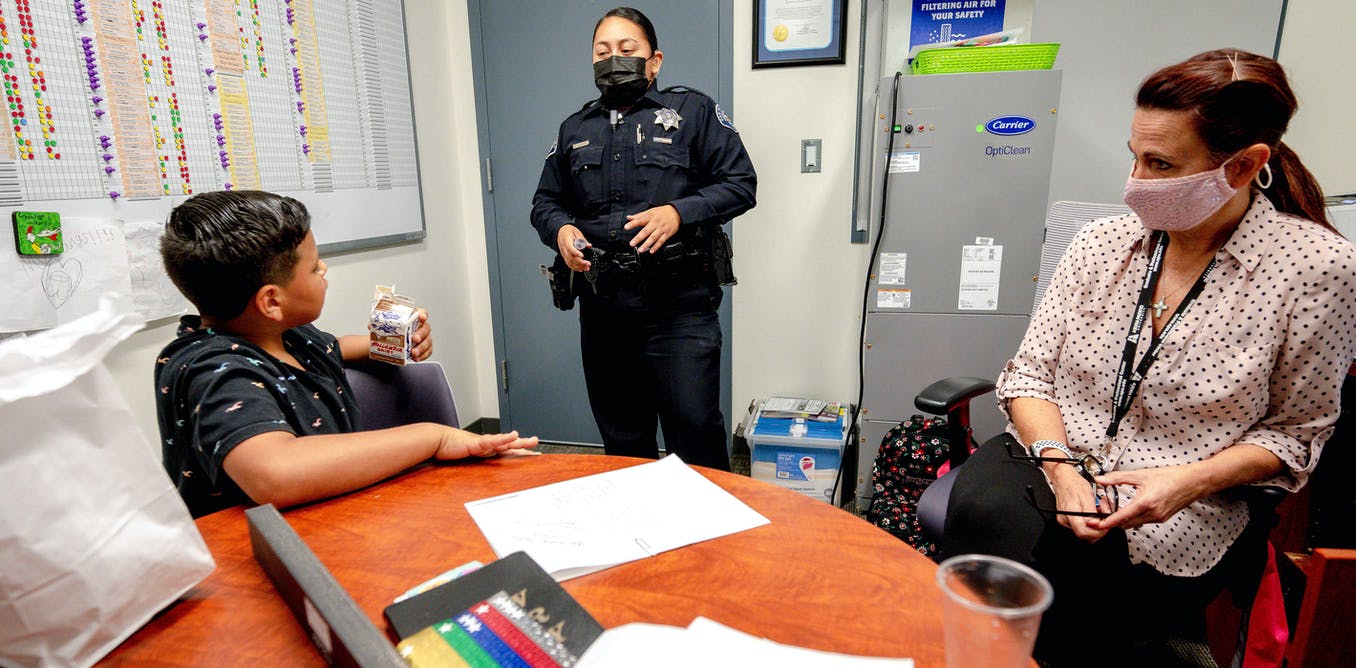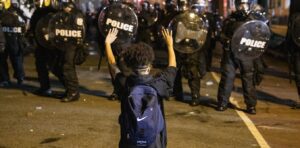Police presence on school grounds poses potential risks to kids

In fall 2020, I got an email from the Phoenix Elementary School District #1, a K-8 school district, requesting feedback on whether to continue using school resource officers in seven of the district’s 14 elementary schools.
As a researcher who specializes in the policing and development of children and adolescents, I responded by sharing a summary of the research on the subject of police in schools and offering my consultation. The school board president asked me to present research to the board on the effects school resource officers had on overall student well-being, school safety
and school climate.
The school board was under pressure to make a decision about a divisive issue with a pending deadline. Parents and teachers were split on the use of school resource officers. Youth were a small but vocal contingent most often against school resource officers.
The school resource officer debate has many sides. This debate comes at a time when communities and police have increasingly strained relations due to police shootings and other negative encounters. It also comes at a time when cities such as Alexandria, Virginia, Washington and Milwaukee are wrestling with whether to have school resource officers or regular police officers on campus.
I believe my experience presenting to the school board in Phoenix offers some important lessons for other communities as they try to figure out if putting police on school premises is an effective way to keep students safe.
A divided community
At the hearing, community members gave emotional testimony. One person said the school resource officer program is a “positive bridge between students, the community and our local police force.”
A teachers’ union representative asked the board to take more time to research and allow more time for a parent survey, which had a low response rate due to the short time parents had to complete the survey. She was also concerned that school resource officers would lead to a disproportionate arrest rates for Black and Latino children.
A teacher spoke of how a school resource officer pepper-sprayed a crowd of students at her school and the next week handcuffed a sixth grade girl.
“Co-workers justified the response by saying ‘we lack the resources’ and ‘children need to be taught a lesson,’” the teacher said at the hearing. “I was told by the principal that the officer could act in this way in order to protect school property.”
The teacher expressed worry that the school district could not hold school resource officers accountable because the officers report to the City of Phoenix.
“How can you allow the most violent police force to be in our schools?” the teacher asked in reference to the Phoenix police department, which is under investigation by the U.S. Department of Justice for its use of deadly force.
A parent said he had a hard time understanding how the school district could commit itself to Black Lives Matter and fighting racism, then weeks later consider bringing police into its schools.
“It isn’t wrong, it is betrayal,” the parent said.
Balancing these divergent perspectives, the superintendent wanted to make his decision based on what research shows. Timing was also an issue since a grant to fund school resource officers required a response within two weeks.
Here are some highlights based on the research I discussed during my presentation to the school board.
Students are still developing
Juveniles may not understand their rights, which is important whenever they could potentially be taken into police custody.
Many children have also experienced trauma, such as being subjected to or having witnessed violence. These experiences can in turn affect their behavior at school. Trauma is most effectively treated with social and emotional support, which police may not be equipped to provide.
Schools counselors are scarce
Despite increased demand for social and emotional support, schools are often short on staff to provide that support. In some states, the ratio of students to counselors is 1,000-to-1, which is four times the ratio recommended by the American School Counselor Association. With less counseling and support, students may be more likely to have negative encounters with police rather than positive ones with counselors. This is especially likely given that mounting evidence shows students are being arrested for minor misbehavior.
Black and Latino youth at greater risk for arrest
A 2018 study of school resource officers found that Black and Latino students and students with disabilities – especially emotional behavioral disorders – were at increased risk for referral to juvenile courts.
Increased police monitoring of young people leads to more school discipline referrals and arrests, typically of Black and Latino youth.
The increased monitoring of ‘at-risk’ youth usually leads to more Black and Latino children getting arrested.
Orlando Police Department/Orlando Sentinel via AP
Difficult decisions
My recommendation was to take more time to consider the issue and the needs of the community. I had concerns that everyone did not have knowledge of the effects of school resource officers on school safety, student well-being and arrest rates.
The superintendent asked me directly what I would do if pressed to make a decision right now. I told the board I thought the potential for harm outweighed the potential for good. Ultimately, the school board voted unanimously not to keep school resource officers in district schools for the next school year.
A national problem
Phoenix’s elementary schools were not the only ones in or near the city struggling with whether to have law enforcement on school grounds. In 2020, Phoenix Union High School voted to remove school resource officers from campus. Nearby Tempe Union High School also voted in 2021 to phase out school resource officers by August 2022.
School board decisions about school safety are difficult. Parents, teachers and students are often at odds about what makes a school safe and welcoming. As school communities continue to wrestle with whether to have police on school grounds, I believe the most important thing to consider is not what people believe, but what the evidence shows.
[Get the best of The Conversation, every weekend. Sign up for our weekly newsletter.]






